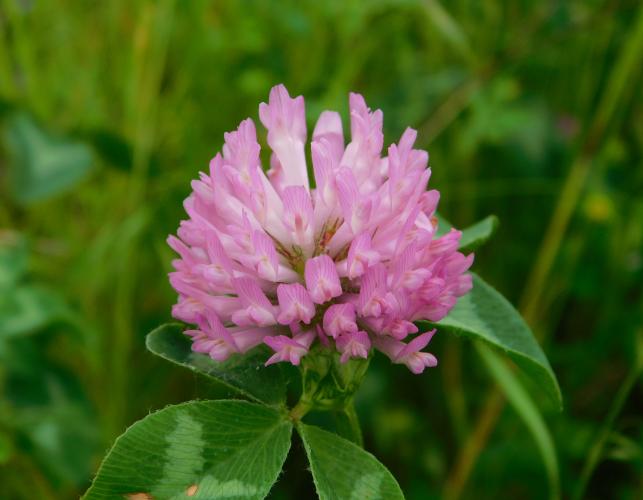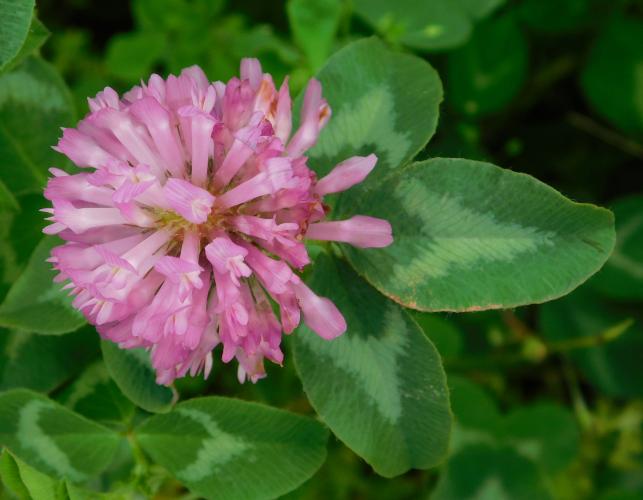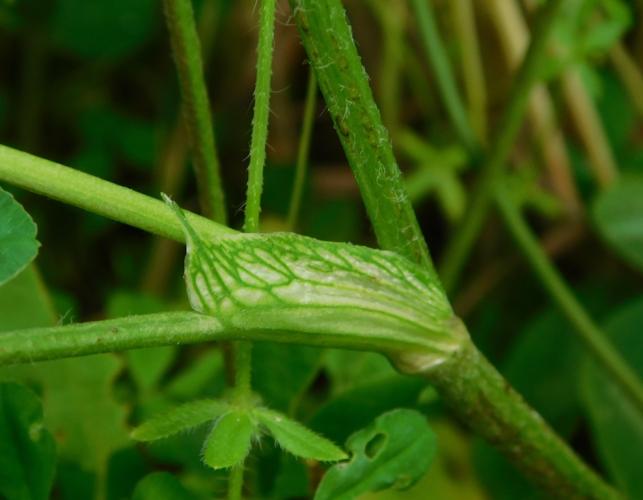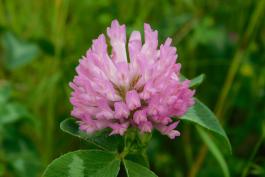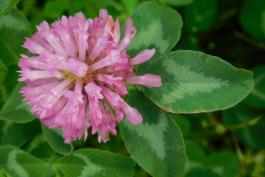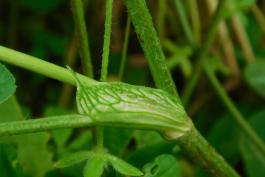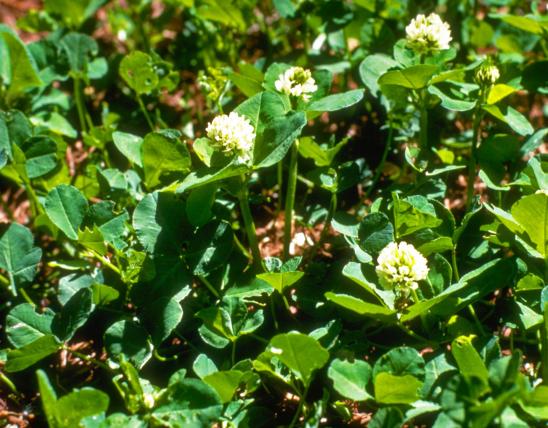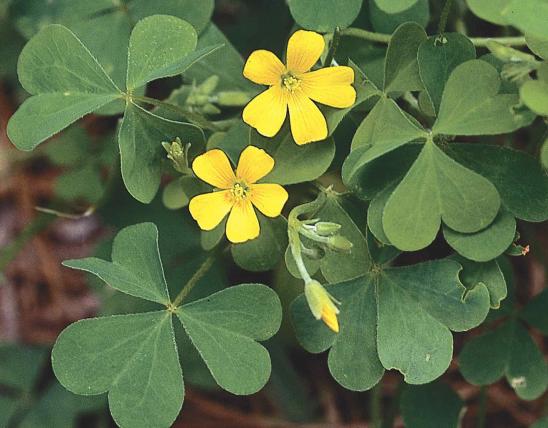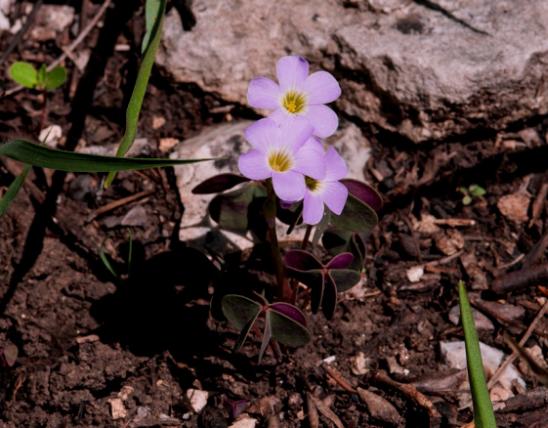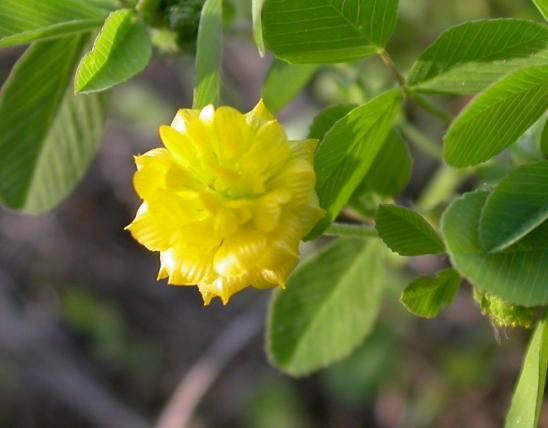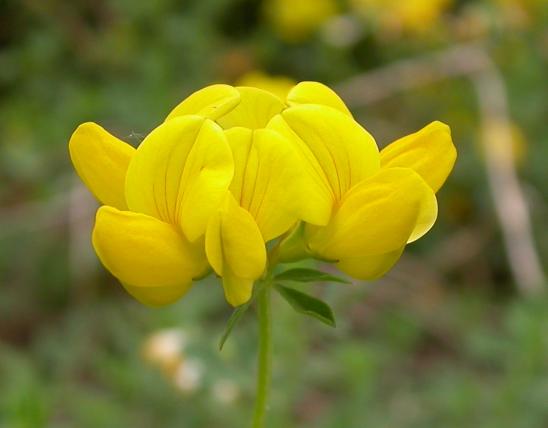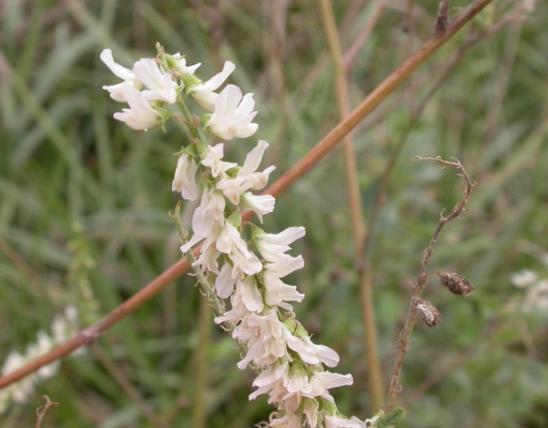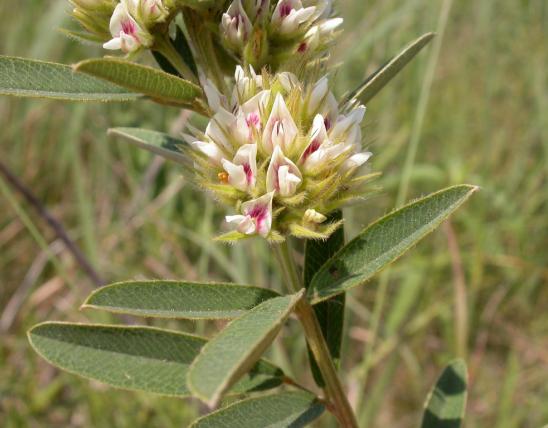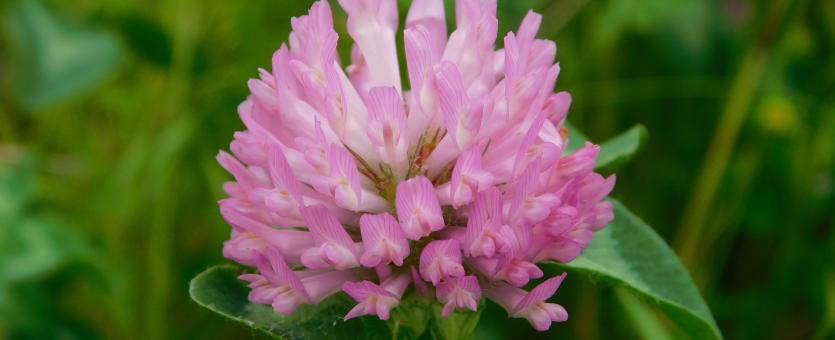
Red clover, or purple clover, is the familiar large, pinkish-purple clover that grows in lawns, pastures, and roadsides statewide. A Eurasian native, it was introduced to North America by the middle 1600s.
You probably know what red clover looks like, but you might not be aware of some fine points of its form. It is a perennial with a short, stout rootstock. The stems are upright, much-branched, and can be hairless or hairy.
The leaves are compound with 3 leaflets; leaf stems are longest at the base of the plant. There is a pair of conjoined leaflike stipules where the leaf stalks join the stem; these stipules are pointed at the tip and strongly veined. Leaflets lack stalks and are mostly oval, the margins scalloped or toothed (often only near the tip); a pale V-shape is usually in the middle of each leaflet.
The flower heads are globe-shaped or egg-shaped, ⅜–1¼ inches in diameter, stalkless (a pair of leaves at the base), with 40–150 florets per head. Petals are reddish purple or (rarely) white. Blooms April–October.
Similar species: Missouri has about 14 species in genus Trifolium. Some are rare and some are common; some are native and some were introduced. Several are yellow or white and therefore not likely to be confused with red clover. But we have a number of pink- or red-blooming clovers that could be confused with red clover:
- Alsike clover, or Alsatian or Swedish clover (T. hybridum), is an introduced European species scattered nearly statewide (least common in the Ozarks). It is a perennial growing from rhizomes. The flower heads are about ½–1 inch in diameter, with 20–80 florets per head. At first, the petals are white, but they become pinkish-tinged and then pink as they mature. Blooms May–October.
- Buffalo clover (T. reflexum) is a native widely scattered statewide, though absent from most of the Bootheel lowlands and much of the western portion of northern Missouri. It is an annual or biennial growing from a taproot. The stem is usually unbranched at the base and is loosely to strongly ascending. The flower heads are about ¾–1½ inches in diameter, with 10–40 florets per head. The petals are usually white to cream-colored but are occasionally deep pink or pinkish-tinged, turning brown at maturity. The stalks of the florets bend over at maturity, giving the entire head a crowned appearance once the florets are spent. Blooms May–August.
- Rabbit’s foot clover (T. arvense) is an introduced Old World species that is widely scattered in Missouri, mostly in the Ozark and Ozark Border regions, mostly in pastures, old fields, roadsides, and other open, disturbed areas. It is a taprooted annual. Its flower heads are oval or cylindrical, about ½ inch wide and becoming about 1 inch long with age, with 10–150 florets per head. The flowers are pale pink and distinctly fuzzy-looking. Blooms May–October.
- Crimson clover, or Italian clover (T. incarnatum), is an introduced European species that is widely scattered in the southern half of Missouri, in pastures, roadsides, and other open, disturbed areas. It’s a taprooted annual. The flower heads are oval or cylindrical, about ¾ inch wide and becoming about 2½ inches long with age, with usually more than 150 florets per head. In our state, this species is distinctly red and not pink. Blooms April–July.
- Persian clover, or reversed clover (T. resupinatum), is an introduced Eurasian species uncommon in Missouri, known only from Newton and St. Louis counties, in lawns and open, disturbed areas. It is a taprooted annual. The flower heads are hemispherical or globe-shaped and are only about ½ inch long and wide, with 6–20 florets per head. The petals are lavender to pink to nearly white. The flowers of this species are resupinate — turned upside-down, with the wide banner petal (usually at the top of pea-family flowers) lowermost. Blooms May–July.
- Knotted clover (T. striatum) is an introduced Eurasian species that is uncommon in Missouri, known only from Scott County, in lawns and open, disturbed areas. It’s a taprooted annual. The flower heads are generally oval, becoming elongated and cylindrical, to about ½ inch wide and about ¾ inch long with age, with 50–120 florets per head. The petals are pink, and the banner petal is oblong and notched. The calyx tube is hairy and becomes inflated at fruiting time. Blooms May–August.
- Arrowleaf clover (T. vesiculosum) is an introduced Eurasian species that is uncommon in Missouri, known only from Howell County, in open, disturbed areas. It’s a taprooted annual. The flower heads are globe-shaped to oval to oblong-oval, about 1¼ inches wide and 1¼ inches long, eventually elongating to nearly 2½ inches, with often more than 150 florets per head. The petals are creamy white, pink, or purple: The oldest, lower florets typically turn brown, and the younger florets at the top are white; florets in between are usually pinkish. Blooms April–July.
Length: stems 8–24 inches; occasionally to 40 inches.
Common nearly statewide.
Status
Introduced perennial wildflower.
Human Connections
Red clover is grown in more areas of the world than any other species of Trifolium. It has been in cultivation since the third and fourth centuries, probably beginning in Spain, whence it spread to Holland and Lombardy, Italy, and then to Germany. It was introduced into England about 1645, and the English brought it to the New World by 1663.
Red clover is a very important forage and fodder crop, but it may also cause bloating in animals that overindulge in its young growth. A diet high in red clover also may cause infertility in sheep.
Red clover, like others in its family, fixes (transforms) nitrogen from the atmosphere into a form that can be used as a nutrient by plants, so it is often planted as a cover crop — a so-called green manure — to increase soil fertility.
Red clover flowers have been used in teas, jellies, and to flavor vinegar. The plant has been used medicinally as an ingredient in cough syrup and in salves to treat eye and skin diseases, among a variety of other medicinal uses.
The young foliage can be cooked as a vegetable. Dried flower heads have been ground and used in breads during times of famine.
Red clover is the official state flower of Vermont. It’s also the national flower of Denmark.
Ecosystem Connections
Bumblebees and other bees with long tongues visit the flowers for nectar and pollen. A wide variety of butterflies and moths visit the flowers, too. Plenty of other insects consume the foliage, including butterfly and moth caterpillars (including the orange, clouded, cloudless, and southern dogface sulphurs, the eastern tailed-blue, and the clover looper). Certain types of leaf beetles, weevils, stinkbugs, aphids, treehoppers, and grasshoppers also make a living from red clover.
Plenty of birds and mammals eat the foliage, flowers, or both: voles, rabbits, groundhogs, ground squirrels, deer, bear, and others. Canada geese, greater prairie-chickens, wild turkey, and ruffed grouse also eat red clover foliage and/or flowers and seeds. Some of the smaller birds that eat the seeds are sparrows, horned larks, and mourning doves.
As a cover crop, red clover helps to reduce erosion. Keeping topsoil out of streams is important for conserving the quality of aquatic habitats, which helps fish and other aquatic animals to survive and thrive.
There are about 250 species in genus Trifolium worldwide. There are three subfamilies in the bean family (Fabaceae) (fah-BAY-cee-ee), and the clovers belong in subfamily Faboideae (fah-BOY-dee-ee), which have the pea-shaped flowers the bean family is known for. In the case of clovers, the pea-shaped flowers are small and clustered together into rounded heads. But if you look closely at each individual floret, you’ll see it has the same configuration of petals as in sweet peas, alfalfa, black locusts, peanuts, string beans, loco weeds, vetches, wild indigos, tick trefoils, wisterias, and more. Each flower has a broad banner (or standard) petal at the top, two side petals called wings, and two petals at the bottom that are usually fused into a boatlike keel. The unique form of these flowers makes them especially attractive to bees.
